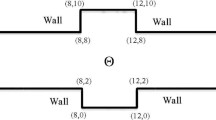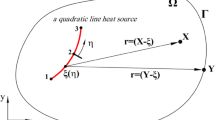Abstract
In this study, a non-Fourier heat conduction problem formulated using the Cattaneo–Vernotte (C–V) model with non-homogeneous boundary conditions is solved with the superposition principle in conjunction with solution structure theorems. It is well known that the aforementioned analytical method is not suitable for such a class of thermal problems. However, by performing a functional transformation, the original non-homogeneous partial differential equation governing the physical problem can be cast into a new form such that it consists of a homogeneous part and an additional auxiliary function. As a result, the modified homogeneous governing equation can then be solved with solution structure theorems for temperatures inside a finite planar medium. The methodology provides a convenient, accurate, and efficient solution to the C–V heat conduction equation with non-homogeneous boundary conditions.












Similar content being viewed by others
Abbreviations
- \( \mathcal{A} \) :
-
Constant, Table 1
Table 1 Constants used in the temperature solutions for the two physical problems - b :
-
External heat flux decaying factor
- \( \mathcal{B} \) :
-
Constant, Table 1
- \( \mathcal{C} \) :
-
Constant, Table 1
- c :
-
Wave speed (m/s)
- c p :
-
Specific heat (J/kg K)
- \( \mathcal{D} \) :
-
Constant, Table 1
- \( \mathcal{E} \) :
-
Constant, Table 1
- \( \mathcal{F} \) :
-
Constant, Table 1
- \( \Im \) :
-
Dimensionless internal heat generation
- f :
-
Forcing function
- f r :
-
Reference heat flux (W/m2)
- f 1 :
-
Boundary condition at x = 0
- f 2 :
-
Boundary condition at x = 1
- g :
-
Dimensionless heat generation
- \( \mathcal{H}_{1} \) :
-
Dimensionless initial condition
- \( \mathcal{H}_{2} \) :
-
Dimensionless initial temperature rate of change
- k :
-
Thermal conductivity (W/m K)
- n :
-
Index
- q :
-
Dimensionless heat flux
- \( q^{*} \) :
-
Heat flux (W/m2)
- q o :
-
Dimensionless incident heat flux magnitude
- Τ :
-
Dimensionless temperature
- \( T^{*} \) :
-
Temperature (K)
- t :
-
Dimensionless time
- \( t^{*} \) :
-
Time (s)
- u :
-
Dimensionless temperature solution for the homogeneous problem
- u 1 :
-
Dimensionless temperature solution due to ψ function contribution
- u 2 :
-
Dimensionless temperature solution due to φ function contribution
- u 3 :
-
Dimensionless temperature solution due to f function contribution
- w :
-
Auxiliary function
- x :
-
Dimensionless slab thickness
- \( x^{*} \) :
-
Slab thickness (m)
- α :
-
Thermal diffusivity, k/ρc p (m2/s)
- \( \gamma_{n} \) :
-
Eigenvalue, \( \sqrt {(n\pi )^{2} - 1 } \)
- ε:
-
Relative error
- \( \zeta \) :
-
Dummy variable for time
- \( \xi \) :
-
Dummy variable for space
- ρ :
-
Density (kg/m3)
- \( \tau_{CV} \) :
-
Relaxation time constant (s)
- φ :
-
Initial temperature function
- ψ:
-
Initial temperature rate of change function
References
Chen JK, Tzou DY, Beraun JE (2005) Numerical investigation of ultrashort laser damage in semiconductors. Int J Heat Mass Transf 48(3–4):501–509
Yeung WK, Lam TT (1999) Thermal analysis of anisotropic thin-film superconductors. In: Advances in electronic packaging, EEP-vol 26-2, pp 1261–1268
Chester M (1963) Second sound in solids. Phys Rev 131:2013–2015
Brown JB, Chung DY, Mathews PW (1966) Heat pulses at low temperatures. Phys Lett 21:241–243
Zhou J, Zhang Y, Chen JK (2008) Non-Fourier heat conduction effect on laser-induced thermal damage in biological tissues. Numer Heat Transf Part A Appl 54(1):1–19
Torii S, Yang W-J (2005) Heat transfer mechanisms in thin film with laser heat source. Int J Heat Mass Transf 48:537–544
Robin JE, Nordin P (1975) Enhancement of CW laser melt-through of opaque solid materials by supersonic transverse gas flow. Appl Phys Lett 26(6):289–292
Maxwell JC (1867) On the dynamic theory of gases. Philos Trans R Soc Lond 157:49–88
Cattaneo C (1958) Sur une forme de l’Equation de la chaleur elinant le paradoxe d’une propagation instantance. Comput Rendus Acad Sci Paris 247:431–433
Vernotte MP (1958) Les Paradoxes de la Theorie Continue de l’Equation de la Chaleur. Comput Rendus Acad Sci Paris 246:3154–3155
Carey GF, Tsai M (1982) Hyperbolic heat transfer with reflection. Numer Heat Transf 5:309–327
Lewandowska M (2001) Hyperbolic heat conduction in the semi-infinite body with a time-dependent laser heat source. Heat Mass Transf 37:333–342
Moosaie A (2008) Non-Fourier heat conduction in a finite medium subjected to arbitrary non-periodic surface disturbance. Int Commun Heat Mass Transf 35:376–383
Ozisik MN, Vick B (1984) Propagation and reflection of thermal waves in a finite medium. Int J Heat Mass Transf 27(10):1845–1854
Tang DW, Araki N (2000) Non-Fourier heat conduction behavior in finite mediums under pulse surface heating. Mater Sci Eng A292:173–178
Wu C-Y (1988) Integral equation solution for hyperbolic heat conduction with surface radiation. Int Commun Heat Mass Transf 15:365–374
Lam TT, Fong E (2011) Application of solution structure theorems to non-Fourier heat conduction problems: analytical approach. Int J Heat Mass Transf 54(23–24):4796–4806
Lam TT, Fong E (2011) Heat diffusion vs. wave propagation in solids subjected to exponentially-decaying heat source: analytical solution. Int J Therm Sci 50(11):2104–2116
Wang LQ, Zhou XS, Wei XH (2008) Heat conduction: mathematical models and analytical solutions. Springer, Heidelberg
Yeung WK, Lam TT (1998) A numerical scheme for non-Fourier heat conduction, part I: one-dimensional problem formulation and applications. Numer Heat Transf Part B Fundam 33(2):215–233
Lam TT (2010) Thermal propagation in solids due to surface laser pulsation and oscillation. Int J Therm Sci 49(9):1639–1648
Author information
Authors and Affiliations
Corresponding author
Rights and permissions
About this article
Cite this article
Lam, T.T., Fong, E. Application of solution structure theorems to Cattaneo–Vernotte heat conduction equation with non-homogeneous boundary conditions. Heat Mass Transfer 49, 509–519 (2013). https://doi.org/10.1007/s00231-012-1097-4
Received:
Accepted:
Published:
Issue Date:
DOI: https://doi.org/10.1007/s00231-012-1097-4




